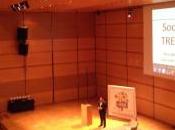In primo luogo abbiamo chiesto a Burt come ha iniziato la sua carriera di giornalista. Il percorso è cominciato abbastanza presto, lavorando al giornale del liceo, interessandosi specialmente di fotografia analogica e degli aspetti più tecnici del mestiere. In seguito ha lavorato per il giornale del college di Stanford, e quindi ha ottenuto un impiego presso l'Associated Press, dove ha lavorato per 12 anni viaggiando in tutto il mondo.
Burt differenzia il giornalismo dal reporting, perché a suo avviso chiunque può essere un reporter, ma non tutti possono essere giornalisti. Il giornalista dà contesto, analizza eventi passati e presenti, indaga su differenze e analogie, guarda i fatti con occhio critico: naturalmente non è necessario lavorare per un'agenzia di stampa per poterlo fare, ma secondo Burt questa funzione è molto più importante e difficile che scattare una foto e pubblicarla su Twitter.
 Abbiamo chiesto se ci saranno future implementazioni per Storify, che potrebbero essere già anticipate: sembrerebbe che l'obiettivo principale è quello di trasformare il pubblico in curatori, e far sì che le persone che leggono, commentano, mettono insieme contenuti che a loro piacciono, possano farlo in maniera molto semplice, senza dover passare per l'intero percorso di creazione di una storia.
Abbiamo chiesto se ci saranno future implementazioni per Storify, che potrebbero essere già anticipate: sembrerebbe che l'obiettivo principale è quello di trasformare il pubblico in curatori, e far sì che le persone che leggono, commentano, mettono insieme contenuti che a loro piacciono, possano farlo in maniera molto semplice, senza dover passare per l'intero percorso di creazione di una storia.Burt ci ha raccontato qualcosa sulle origini di Hacks and Hackers, progetto nato durante il soggiorno a Stanford con l'obiettivo di mettere in contatto tra loro le persone che si occupano di tecnologia e i giornalisti, le media company e le agenzie tecnologiche. Secondo Burt il confine tra le due tipologie è talmente sottile che ormai non sono più distinguibili: qualsiasi media company ha bisogno della tecnologia per poter andare online e pubblicare i propri contenuti, quindi le media company stanno diventando un po' aziende tecnologiche e viceversa.
Infine abbiamo chiesto a Burt quale sia la sua dieta mediatica: non legge giornali cartacei, ma riceve molte newsletter e legge alcuni feed RSS attraverso l'applicazione Pulse per iPad. Non utilizza Twitter come fonte di informazione, ma predilige alcuni servizi che aggregano i contenuti più interessanti della giornata e li propongono in ordine di rilevanza. Secondo lui infatti questo ruolo di curation diventerà sempre più importante man mano che la quantità di contenuti aumenta, e che permetterà di distinguere le cose importanti da quelle meno importanti, e controllare il continuo flusso di informazioni che rischia di sommergere senza dare la possibilità di poter mai "finire" di leggere.
Vi invito a visionare l'intervista integrale, senz'altro più ricco di dettagli e spunti rispetto a questa mia breve sintesi.
Buona visione!
Maria Petrescu
Intervistato.com | Burt Herman #ijf12
The sixth interview for the Intervistato Journalism Series is with Burt Herman, American journalist known for being the founder of Storify and Hacks&Hackers.
First of all we asked Burt how he started his carreer as a journalist. The path started early on, working at the highschool newspaper, and growing an interest for b/w photography and all the technical aspects of the trade. Then he worked for the college newspaper at Stanford, and then he got a job at the AP, where he worked for 12 years travelling all around the world.
Burt differentiates journalism from reporting, because in his opinion anyone can be a reporter, but not anyone can be a journalist. A journalist gives context, analyzes past and present events, draws parallels, finds differences and analogies, looks at facts with a critical eye: of course you don't have to work for a news company in order to do this, but the function itself is far more important and difficult than just snapping a picture and uploading it on Twitter.
We asked if there will be further developments for Storifythat he can already talk to us about: it would seem that the main goal is to transform audiences in curators, so that people who read, comment and put together things that they like can do it in a very simple manner, without going through the whole process of creating a story.
Burt also told us something about the origins of Hacks and Hackers, which was born during his stay at Stanford, with the goal of connecting people who deal with technology and journalists, media companies and technology companies. Burt thinks that the two are so similar now, that they've almost become indistinguishable: any media company needs technology in order to put content online, so media companies are becoming more and more technology companies and viceversa.
Finally we asked Burt what his media diet is: he doesn't read paper newspapers, but he receives a lot of email newsletters and reads a few RSS feeds through Pulse, the iPad app. He doesn't use Twitter as a source of information, but he does use a few services that aggregate the most interesting content of the day and propose it in order of relevance. In his opinion this role of curation will become more and more important as content becomes more and more abundant, and it will distinguish the more important things from the less important, and control the continuous flow of information that risks to submerge us without ever giving us the posibility to "finish" anything.
I invite you to view the full interview, much richer in details and insights than my brief synthesis.
Enjoy!
Maria Petrescu




